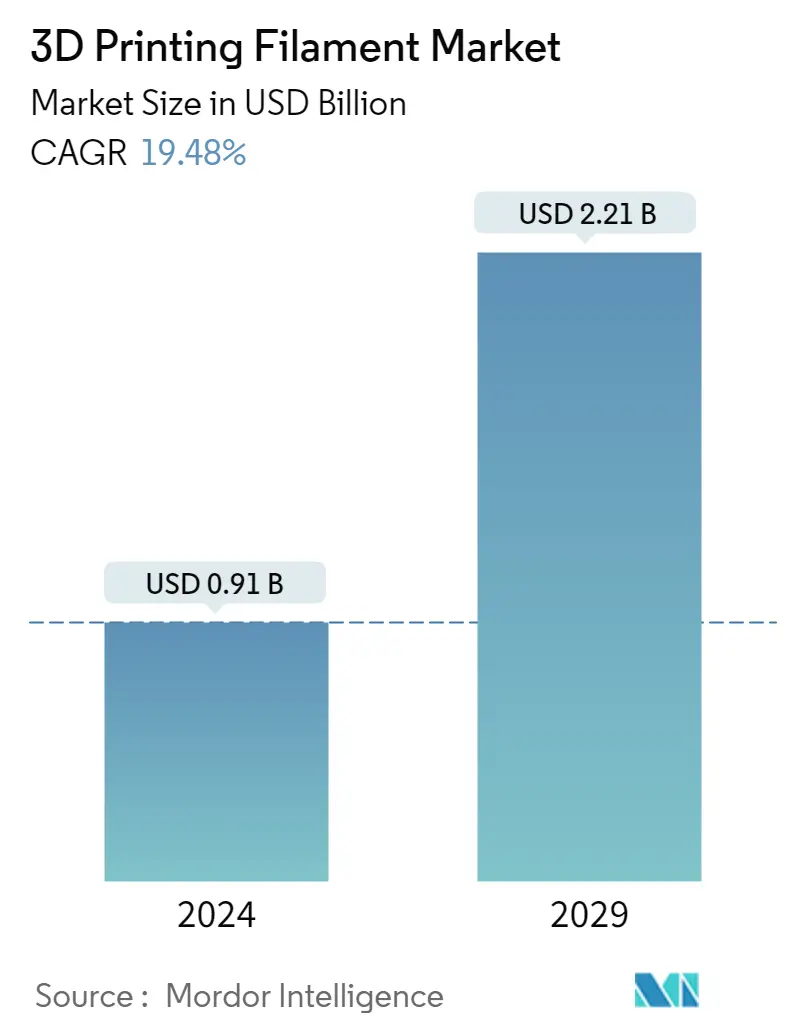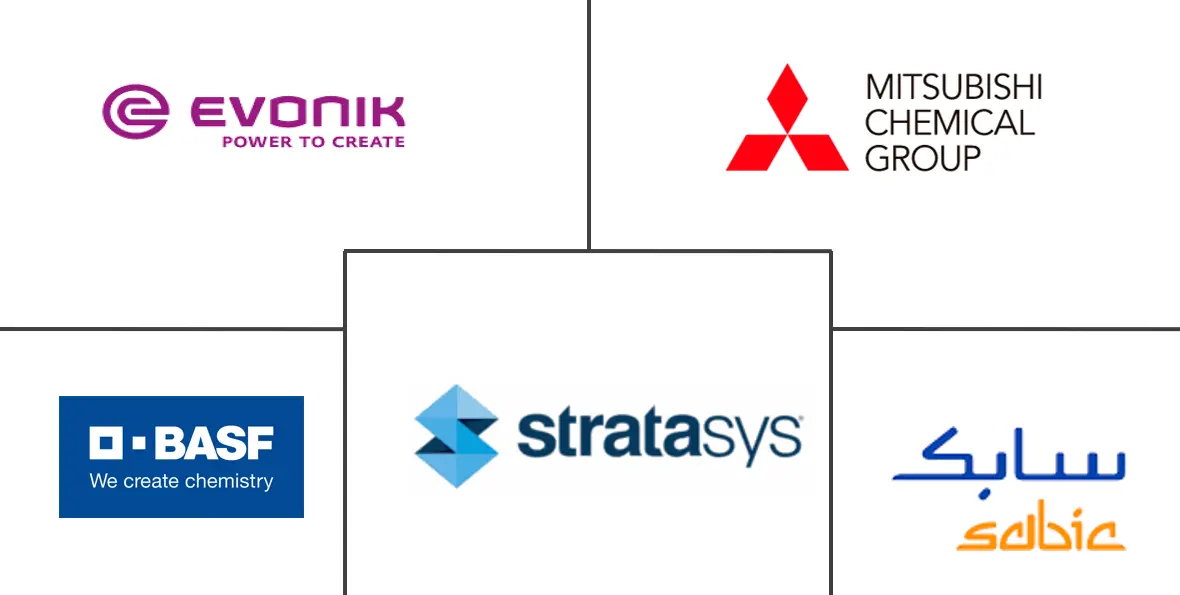Market Size of 3D Printing Filament Industry

| Study Period | 2019 - 2029 |
| Market Size (2024) | USD 0.91 Billion |
| Market Size (2029) | USD 2.21 Billion |
| CAGR (2024 - 2029) | 19.48 % |
| Fastest Growing Market | Asia-Pacific |
| Largest Market | Europe |
Major Players
*Disclaimer: Major Players sorted in no particular order |
3D Printing Filament Market Analysis
The 3D Printing Filament Market size is estimated at USD 0.91 billion in 2024, and is expected to reach USD 2.21 billion by 2029, growing at a CAGR of 19.48% during the forecast period (2024-2029).
The COVID-19 outbreak caused nationwide lockdowns around the world, disruption in manufacturing activities and supply chains, and production halts, all of which had a negative impact on the market in 2020. However, conditions began to improve in 2021-2022, which is expected to boost market growth during the forecast period.
- Over the short term, the growing usage of 3D printing filament in manufacturing applications along with mass customization associated with 3D printing are the factors driving the market demand during the forecast period.
- On the flip side, high capital investment requirements in the 3D printing process is hindering the market's growth.
- 3D printing innovation in the medical sector and advancements in 3D printing materials may likely act as growth opportunities for the 3D printing filament market in the future.
- Europe is expected to dominate the market with largest market share in the forecast period.
3D Printing Filament Industry Segmentation
3D printer filament is a type of printing material used by the FFF type 3D printer. It is one of the most common 3D printing materials in the world. It is mostly made of thermoplastic. However, metal, ceramics, and other materials are also used to make 3D printing filaments. The 3D printing filament market report is segmented by type, application, and geography. By type, the market is segmented into metals, plastics, ceramics, and other types. By application, the market is segmented into aerospace and defense, automotive, medical and dental, electronics, and other applications. The report also covers the market size and forecasts for the 3D printing filament market in 15 countries across major regions. For each segment, the market sizing and forecasts have been done based on revenue (USD Million).
| Type | |||||||
| |||||||
| |||||||
| Ceramics | |||||||
| Other Types |
| Application | |
| Aerospace and Defense | |
| Automotive | |
| Medical and Dental | |
| Electronics | |
| Other Applications |
| Geography | |||||||
| |||||||
| |||||||
| |||||||
| |||||||
|
3D Printing Filament Market Size Summary
The 3D printing filament market is poised for significant growth over the forecast period, driven by increasing applications in manufacturing and the trend towards mass customization. The market experienced setbacks due to the COVID-19 pandemic, which disrupted manufacturing and supply chains, but recovery began in 2021-2022. The medical and dental industries are the primary consumers of 3D printing filaments, utilizing them for creating advanced medical devices and custom prosthetics. Innovations in 3D printing materials and technologies, particularly in the medical sector, present substantial growth opportunities. However, the high capital investment required for 3D printing processes remains a challenge to market expansion. Europe is anticipated to lead the market, with Germany, the United Kingdom, and France playing significant roles due to their robust economies and advancements in sectors like aerospace and electronics.
The European region's dominance in the 3D printing filament market is supported by its strong medical technology and aerospace industries, alongside a thriving electronics sector. The presence of numerous medical technology companies, particularly in Germany, and the increasing demand for 3D printed medical devices contribute to market growth. The region's investment in healthcare and defense further boosts the demand for 3D printing filaments. The market is characterized by fragmentation, with major players like Stratasys Ltd, SABIC, BASF SE, Evonik Industries AG, and Mitsubishi Chemical Corporation holding significant market shares. Recent strategic moves, such as Covestro AG's acquisition by Stratasys and Evonik's expansion of its filament offerings, highlight the dynamic nature of the market and the ongoing efforts to enhance product capabilities and market reach.
3D Printing Filament Market Size - Table of Contents
-
1. MARKET DYNAMICS
-
1.1 Drivers
-
1.1.1 Growing Usage in Manufacturing Applications
-
1.1.2 Mass Customization Associated with 3D Printing
-
-
1.2 Restraints
-
1.2.1 High Capital Investment Requirement in 3D Printing Process
-
-
1.3 Industry Value Chain Analysis
-
1.4 Porter's Five Forces Analysis
-
1.4.1 Bargaining Power of Suppliers
-
1.4.2 Bargaining Power of Buyers
-
1.4.3 Threat of New Entrants
-
1.4.4 Threat of Substitute Products and Services
-
1.4.5 Degree of Competition
-
-
-
2. MARKET SEGMENTATION (Market Size in Value)
-
2.1 Type
-
2.1.1 Metals
-
2.1.1.1 Titanium
-
2.1.1.2 Stainless Steel
-
2.1.1.3 Other Metals
-
-
2.1.2 Plastics
-
2.1.2.1 Polyethylene Terephthalate (PET)
-
2.1.2.2 Polylactic Acid (PLA)
-
2.1.2.3 Acrylonitrile Butadiene Styrene (ABS)
-
2.1.2.4 Nylon
-
2.1.2.5 Other Plastics
-
-
2.1.3 Ceramics
-
2.1.4 Other Types
-
-
2.2 Application
-
2.2.1 Aerospace and Defense
-
2.2.2 Automotive
-
2.2.3 Medical and Dental
-
2.2.4 Electronics
-
2.2.5 Other Applications
-
-
2.3 Geography
-
2.3.1 Asia-Pacific
-
2.3.1.1 China
-
2.3.1.2 India
-
2.3.1.3 Japan
-
2.3.1.4 South Korea
-
2.3.1.5 Rest of Asia-Pacific
-
-
2.3.2 North America
-
2.3.2.1 United States
-
2.3.2.2 Canada
-
2.3.2.3 Mexico
-
-
2.3.3 Europe
-
2.3.3.1 Germany
-
2.3.3.2 United Kingdom
-
2.3.3.3 France
-
2.3.3.4 Italy
-
2.3.3.5 Rest of Europe
-
-
2.3.4 South America
-
2.3.4.1 Brazil
-
2.3.4.2 Argentina
-
2.3.4.3 Rest of South America
-
-
2.3.5 Middle-East and Africa
-
2.3.5.1 Saudi Arabia
-
2.3.5.2 South Africa
-
2.3.5.3 Rest of Middle-East and Africa
-
-
-
3D Printing Filament Market Size FAQs
How big is the 3D Printing Filament Market?
The 3D Printing Filament Market size is expected to reach USD 0.91 billion in 2024 and grow at a CAGR of 19.48% to reach USD 2.21 billion by 2029.
What is the current 3D Printing Filament Market size?
In 2024, the 3D Printing Filament Market size is expected to reach USD 0.91 billion.

